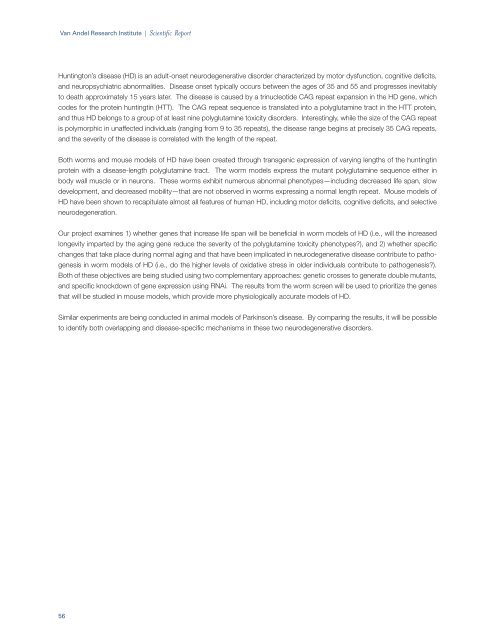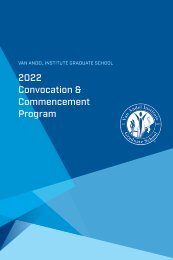2013 Scientific Report
You also want an ePaper? Increase the reach of your titles
YUMPU automatically turns print PDFs into web optimized ePapers that Google loves.
Van Andel Research Institute | <strong>Scientific</strong> <strong>Report</strong><br />
Huntington’s disease (HD) is an adult-onset neurodegenerative disorder characterized by motor dysfunction, cognitive deficits,<br />
and neuropsychiatric abnormalities. Disease onset typically occurs between the ages of 35 and 55 and progresses inevitably<br />
to death approximately 15 years later. The disease is caused by a trinucleotide CAG repeat expansion in the HD gene, which<br />
codes for the protein huntingtin (HTT). The CAG repeat sequence is translated into a polyglutamine tract in the HTT protein,<br />
and thus HD belongs to a group of at least nine polyglutamine toxicity disorders. Interestingly, while the size of the CAG repeat<br />
is polymorphic in unaffected individuals (ranging from 9 to 35 repeats), the disease range begins at precisely 35 CAG repeats,<br />
and the severity of the disease is correlated with the length of the repeat.<br />
Both worms and mouse models of HD have been created through transgenic expression of varying lengths of the huntingtin<br />
protein with a disease-length polyglutamine tract. The worm models express the mutant polyglutamine sequence either in<br />
body wall muscle or in neurons. These worms exhibit numerous abnormal phenotypes—including decreased life span, slow<br />
development, and decreased mobility—that are not observed in worms expressing a normal length repeat. Mouse models of<br />
HD have been shown to recapitulate almost all features of human HD, including motor deficits, cognitive deficits, and selective<br />
neurodegeneration.<br />
Our project examines 1) whether genes that increase life span will be beneficial in worm models of HD (i.e., will the increased<br />
longevity imparted by the aging gene reduce the severity of the polyglutamine toxicity phenotypes?), and 2) whether specific<br />
changes that take place during normal aging and that have been implicated in neurodegenerative disease contribute to pathogenesis<br />
in worm models of HD (i.e., do the higher levels of oxidative stress in older individuals contribute to pathogenesis?).<br />
Both of these objectives are being studied using two complementary approaches: genetic crosses to generate double mutants,<br />
and specific knockdown of gene expression using RNAi. The results from the worm screen will be used to prioritize the genes<br />
that will be studied in mouse models, which provide more physiologically accurate models of HD.<br />
Similar experiments are being conducted in animal models of Parkinson’s disease. By comparing the results, it will be possible<br />
to identify both overlapping and disease-specific mechanisms in these two neurodegenerative disorders.<br />
56
















